About painting…
Back then, in a grim and dark past, there was no such thing as washes on the market, and their counterparts, classic inks, were not as widespread as they are today. In the coming articles I will talk a little about the painting of figures in general and my personal preferences and experiences. A good start is my basic attitude towards this part of the hobby, or better yet, how it has changed over time. This will become clearer in the course of the further articles.
I returned to the hobby in 2001 when an old friend of mine met me in my american football club and I happened to see his models when we hung out one day. Since I was active in the hobby for a short time in my youth, it didn't seem strange to me and I thought, "Oh, that looks cool, but...what is it?". Because, the first time, I had seen the miniature hobby in a shop of the chain Welt der Spiele (Games Workshop stores didn't exist like sand at the sea at that time) and didn't know a single game system. Primarily the optical attraction had pulled me into the shop. The models covered the usual range from Fantasy to SciFi of different manufacturers.
In any case, over time I had had the desire to reach a level of painting that would approach a competition level. The internet was still in its childhood stages, but became a more and more important part of the hobby and in 2007 I had seen so many great models that were brought to life by their paintwork that I wanted the same.
During this time the Orcboss came out on foot and on a boar and I tried my best to be one of the first to paint this model up - because at that time you got the most feedback if you painted the most current models. I also played Warhammer Fantasy, which I will talk about again later.
Other than today, the range of colors covered only "ordinary" colors, and in my army the orcs and goblins were mostly uniform, painted with dark clothes and a few red accents. By the way, these models were painted rather fast, but for character models most of the players took their time, because they were very eye-catching on the field. So this time I used Shadow Grey instead of Codex Grey for the black of the clothes, which turned out to be a little bluish. I also didn't know how to highlight red at that time and had tried to accentuate it with Dwarf Flesh after a tip from a forum. Meanwhile I have several methods for that.
It was particularly difficult for me, and this is still the case today, to paint larger organic surfaces, such as the skin of the boar. I still remember accentuating the base colour Scorched Brown in several steps, only to darken it again by diluting the base colour with water and patiently sweeping it over and over again. I had learned this method the first time I tried to paint rust. What today is quickly done with a Technical Color, I had to apply with Dark Flesh, diluted with a lot of water, over rivets and bolts until the desired result was achieved. For larger metal surfaces, I also applied a little black glaze.
"Glazing" is a word that I hardly read in German-speaking forums these days, because with the appearance of Washes from different manufacturers, painting figures has become so much easier. Especially the coat with the wolf fur, where I also tried a new color (white), would have been quickly done with Washes at that time. However back then, it was a wild mixture of grey, brown and black glazes, so thin that it drove me to crazy to put all the effort into it until I finally saw some useful result. But that didn't happen until I thought, "Come on, whatever. Just go on." and I placed the accents afterwards. Only now did the different shades begin to show their effect and I began to understand: a medium hue, a shadow and an accent only showed an optically interesting effect if you could see them in combination.
As you can see, this model was a great experiment with even greater ambitions at that time. Many things were discovered in this model that I had never tried before. Lightening up black with something other than grey, white fur, a red blanket, dark orc skin, which I darkened with purple instead of black, horns and hooves, with which I tried out bony colours, leather straps, which had turned out much too yellow for my taste...
...and freehands. Freehands? "There aren't any." some readers might think, but in fact I had started to think about how I could portray something without it really being modeled on the miniature. For example, rust can have a rough surface that's very easy to model on, but painted on it looks better. What bothered me about the model at the time was that the wild boar had no nostrils. So I tried to paint them on.
I followed the same experiences I had made before - for deeper areas I darkened the basic colour to a certain extent and accentuated areas that would be higher on a model. By leaving the borders of the wrinkles dark, I was able to achieve a slightly three-dimensional effect even though the surface was flat.
The Waaaghboss on wild boar is still in my collection and will probably be preserved for the rest of my life because I associate so many memories with this model. The most valuable experience I have drawn from this model is that it makes sense to have a model where you try a lot of things. Nothing improves your skills as much as testing on a model.
In the next article I'll go into Freehands a bit more and give you a little advice that helped me a lot.
Greetings from the Chaosbunker
Dino
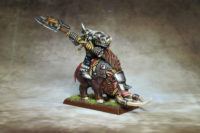
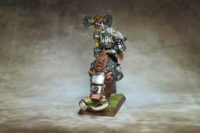
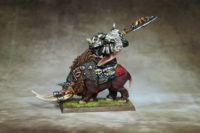
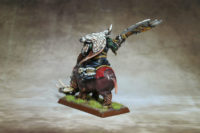
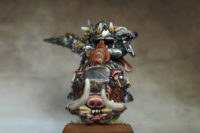
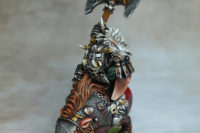
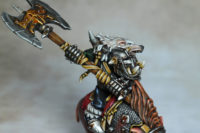












Leave a Reply